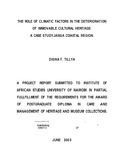| dc.description.abstract | The purpose of this study was to investigate how climatic condition leads to the
deterioration of immovable cultural heritage along the coast of Tanga. Therefore, study
aimed at finding out whether climate was the factor brings about the deterioration of
immovable cultural heritage along the coast of Tanga and its influence on the biological
and environmental aggressors. The project cover historical building and landscape scenes
In addition all the deterioration caused by the climatic condition were identified and
recorded together with its cultural and historical properties.
In order to capture the above stated objective the study was guided by the following
hypothesis. Coastal climatic conditions lead to the deterioration of immovable cultural
heritage. Second coastal climatic conditions do not lead to the deterioration of immovable
cultural heritage.
The major findings have revealed that the deterioration of immovable cultural heritage
along the coast of Tanga are directly and indirectly attributed to climatic conditions. The
climatic agent which include humidity, rainfall, temperature and wind caused decay of
wooden construction materials, cracking and splitting of walls due to contraction and
expansion. Corrosion of iron sheet, peeling off of wall plaster and falling down of some
walls of historic building was also noticed. Furthermore, it became evident that the climatic
condition indirectly provided a conducive environment for the growth of plants,
microorganism and insect pests leading to deterioration of construction materials on
immovable cultural heritage.
With such research findings one can conclude that climatic condition as a natural aggressor
play a significant role in deterioration of immovable cultural heritage along the coast of
Tanga. However this does not mean diminishing the role of human being. The study
therefore recommend for regular condition survey, rehabilitation and maintenance of
immovable cultural heritages. | en |

